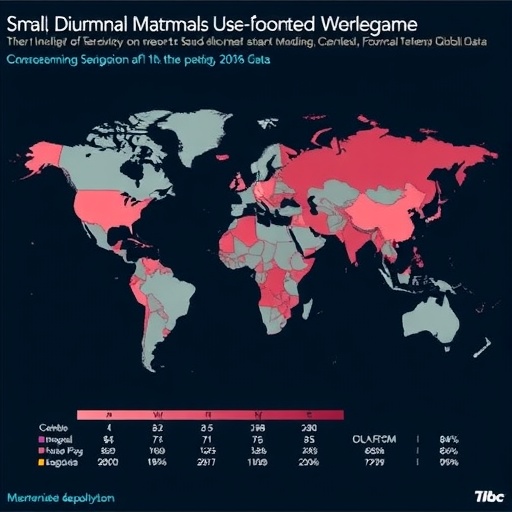In recent years, the application of community science has increased significantly, providing a valuable avenue for researchers to gather vast amounts of data on wildlife. However, a recent study by Forti and Szabo highlights a troubling discrepancy in the recording of mammal populations. Their findings reveal that global community science efforts are failing to adequately represent small and diurnal mammals, a gap that could have significant implications for conservation strategies and ecological understanding.
Community science, often referred to as citizen science, incorporates the collective efforts of non-professionals who contribute to scientific research. By logging observations of wildlife, individuals help create databases that researchers can employ for various ecological studies. However, as Forti and Szabo point out, not all species are represented equally in these community science data sets. The underreporting of small and diurnal species poses a challenge to our understanding of mammal diversity and abundance in ecosystems worldwide.
The authors focused on key factors that contribute to this underreporting, including the challenges of detecting small mammals and the diurnal species that display less conspicuous behaviors compared to their nocturnal counterparts. Many small species have intricate habitats or mimic their environment, making them difficult to spot even for seasoned observers. This invisibility can lead to inaccurate assessments of their populations and the roles they play in their ecosystems.
Moreover, the study underscores the significance of professional guidance in community science initiatives. While amateur observations are invaluable, incorporating scientific methodologies can greatly enhance the accuracy of recorded data. Training volunteers to recognize subtle behaviors and habitat preferences of small and diurnal mammals could improve detection rates, thereby yielding a more holistic understanding of mammal diversity and population dynamics. Through targeted training and clear guidelines, researchers could empower local communities to contribute more effectively to wildlife monitoring.
The implications of overlooking small and diurnal mammals extend beyond mere data collection; they also resonate with conservation efforts. Protecting species that play vital roles in their ecosystems requires informed decision-making based on accurate data. If certain species are continually underreported, it may lead to inadequate conservation strategies that overlook critical areas where intervention is necessary. This knowledge gap can hinder biodiversity conservation efforts, which are essential for maintaining ecological balance.
Furthermore, the underreporting issue raises questions about the overall efficacy of community science as a tool for environmental monitoring. While it has successfully engaged public interest in scientific endeavors, the data’s limitations necessitate re-evaluation. Scientists and wildlife organizations must explore ways to enhance citizen science methodologies to ensure that all species, regardless of size or activity period, are represented accurately.
As researchers delve deeper into the implications of their findings, they emphasize the need for a paradigm shift within the community science framework. A collaborative approach that fosters partnerships between scientists and citizen researchers can pave the way for more accurate data collection. Encouraging a diverse group of participants to engage in monitoring efforts may facilitate a broader reach, capturing observations from varied geographical regions and habitats.
In response to these findings, wildlife conservationists are advocating for strategic initiatives that target the characteristics of small and diurnal mammals. This includes the development of advanced technologies such as camera traps, acoustic monitoring devices, and mobile applications that can assist in detecting these elusive species. By integrating innovative tools with community efforts, researchers can work towards creating a more comprehensive database that encompasses all mammal species.
The urgency of addressing this issue cannot be understated, especially in light of global biodiversity crises. As habitats are lost and species face unprecedented threats, having precise data on population sizes and distributions becomes crucial. The responsibility lies with researchers, conservationists, and community scientists alike to bridge the gaps in data collection and narrative surrounding small and diurnal mammals.
Looking ahead, Forti and Szabo’s study serves as a clarion call for action. It prompts scientists to refine community science initiatives and encourages volunteers to become keen observers of the natural world. By redefining protocols for observation and fostering collaboration, the scientific community can inspire widespread engagement and support for biodiversity.
Overall, the underreporting of small and diurnal mammals shines a spotlight on the complexities of wildlife monitoring. The field of community science must evolve to encompass the full spectrum of life, thereby ensuring that every species is accounted for in conservation efforts. This study opens doors for future research and highlights the importance of continued discourse around the capabilities and limitations of community science.
As researchers communicate these findings widely, it is essential to cultivate a culture where the contributions of community scientists are valued and understood. By reinforcing the idea that every observation counts, conservationists can galvanize public enthusiasm for wildlife protection and contribute significantly to ecological knowledge.
In conclusion, as the dynamics of our world continue to shift, the relevance of accurate data becomes increasingly pronounced. Forti and Szabo’s research not only illuminates the current gaps but ignites a conversation about the power of collective action in scientific inquiry. The future of ecological research relies on the collaboration between professional scientists and enthusiastic volunteers, driving home the message that together, we can combat the biodiversity crisis facing our planet.
This initiative is not merely about gathering data but forging a robust understanding of life on Earth, ensuring that even the smallest, most fleeting members of the mammalian family receive the attention they deserve. Through awareness and action, we can hope to foster a brighter future for all species that inhabit our planet.
Subject of Research: Mammal underreporting in community science data
Article Title: Global community science data on mammals underreport small and diurnal species
Article References:
Forti, L.R., Szabo, J.K. Global community science data on mammals underreport small and diurnal species.
Environ Monit Assess 197, 1251 (2025). https://doi.org/10.1007/s10661-025-14654-7
Image Credits: AI Generated
DOI: 10.1007/s10661-025-14654-7
Keywords: Community science, Mammals, Biodiversity, Conservation, Data collection, Underreporting.




